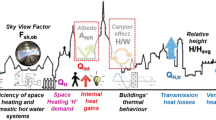Abstract
A simple urban energy balance model for mesoscale simulations (SUMM) was tested using results from an outdoor scale-model experiment. The model geometry is assumed to be an infinitely extended regular array of uniform buildings, each of which is composed of six faces (roof, floor, and four vertical walls). The SUMM explicitly considers the three dimensionality of surface geometry and theoretically predicts the energy balance at each face without time-consuming iterations. The SUMM was compared with outdoor scale-model experiments. The simulated energy balance and surface temperatures agree well with the values measured on a reduced-scale hardware model corresponding to the numerical model geometry.
Similar content being viewed by others
References
A. J. Arnfield (1982) ArticleTitle‘An Approach to the Estimation of the Surface Radiative Properties and Radiation Budgets of Cities’ Phys. Geogr 3 97–122
J. F. Barlow S. E. Belcher (2002) ArticleTitle‘A Wind Tunnel Model for Quantifying Fluxes in the Urban Boundary Layer’ Boundary-Layer Meteorol 104 131–150 Occurrence Handle10.1023/A:1015555613672
J. F. Barlow I. N. Harman S. E. Belcher (2004) ArticleTitle‘Scalar Fluxes from Urban Street Canyons. Part I: Laboratory Simulation’ Boundary-Layer Meteorol 113 369–385
I. P. Castro A. G. Robins (1977) ArticleTitle‘The Flow Around a Surface-mounted Cube in Uniform and Turbulent Streams’ J. Fluid Mech 79 307–335
J. R. Garratt (1992) The Atmospheric Boundary Layer Cambridge University Press U.K. 316
J. R. Garratt R. J. Francey (1978) ArticleTitle‘Bulk Characteristics of Heat Transfer in the Unstable Baroclinic Atmospheric Boundary Layers’ Boundary-Layer Meteorol 15 399–421 Occurrence Handle10.1007/BF00120603
C. S. B. Grimmond T. R. Oke (1999) ArticleTitle‘Aerodynamic Properties of Urban Area Derived from Analysis of Surface Form’ J. Appl. Meteorol 38 1262–1292 Occurrence Handle10.1175/1520-0450(1999)038<1262:APOUAD>2.0.CO;2
Hagishima, A., Tanimoto, J., and Narita, K.: 2005, ‘Review of Experimental Research on the Convective Heat Transfer Coefficient of Urban Surfaces’, Boundary-Layer Meteorol. In Press.
Kanda, M. and Moriwaki, R.: 2002, ‘Surface Parameters in a Densely Built-up Residential Area in Tokyo’, Fourth Symposium Urban Environment, AMS, Norfolk, U.S.A., pp. 147–148.
M. Kanda A. Inagaki O.Z Marcus S. Raasch T. Watanabe (2004a) ArticleTitle‘LES Study of The Energy Imbalance Problem with Eddy Covariance Fluxes’ Boundary-Layer Meteorol 110 381–404 Occurrence Handle10.1023/B:BOUN.0000007225.45548.7a
M. Kanda R. Moriwaki F. Kasamatsu (2004b) ArticleTitle‘Large Eddy Simulation of Turbulent Organized Structure Within and Above Explicitly Resolved Cube Arrays’ Boundary-Layer Meteorol 112 343–368 Occurrence Handle10.1023/B:BOUN.0000027909.40439.7c
Kanda, M.: 2005, ‘Progress in the Scale Modeling of Urban Climate: Review’, Theor. Appl.Climatol., In Press.
M. Kanda T. Kawai K. Nakagawa (2005) ArticleTitle‘Simple Theoretical Radiation Scheme for Regular Building Array’ Boundary-Layer Meteorol 114 71–90 Occurrence Handle10.1007/s10546-004-8662-4
H. Kusaka H. Kondo Y. Kikegawa F. Kimura (2001) ArticleTitle‘A Simple Single-layer Urban Canopy Model for Atmospheric Models: Comparison with Multi-layer and Slab Models’ Boundary-Layer Meteorol 101 329–358 Occurrence Handle10.1023/A:1019207923078
R. W. Macdonald R. F. Griffiths D. J. Hall (1998) ArticleTitle‘An Improved Method for the Estimation of Surface Roughness of Obstacle Arrays’ Atmos. Environ 32 1857–1864 Occurrence Handle10.1016/S1352-2310(97)00403-2
A. Martilli A. Clappier M. W. Rotach (2002) ArticleTitle‘An Urban Surface Exchange Parameterization for Mesoscale Models’ Boundary-Layer Meteorol 104 261–304 Occurrence Handle10.1023/A:1016099921195
V. Masson (2000) ArticleTitle‘A Physically-Based Scheme for the Urban Energy Budget in Atmospheric Models’ Boundary-Layer Meteorol 94 357–397 Occurrence Handle10.1023/A:1002463829265
R. Moriwaki M. Kanda (2003) ArticleTitle‘Radiation, Heat, Water-vapor and CO2 Fluxes in an Urban Surface Layer’ J. Japan Soc. Hydrol. Water Resour 16 477–490
R. Moriwaki M. Kanda (2004) ArticleTitle‘Seasonal and Diurnal Fluxes of Radiation, Heat, Water Vapor and CO2over a Suburban Area’ J. Appl. Meteorol 43 1700–1710 Occurrence Handle10.1175/JAM2153.1
Narita, K.: 2003, ‘Wind Tunnel Experiment on Convective Transfer Coefficient in Urban Street Canyon’, Fifth International Conference on Urban Climate, Lodz, Poland, pp. 355–358.
Narita, K.: 2004, ‘Effects of Building-Height Heterogeneity on Area-Averaged Transfer Velocity in the Street Surface-Wind Tunnel Experiments Using Salinity Change Technique’,Fifth Symposium on Urban Environment, AMS, Vancouver, Canada, O6.8.
Rotach, M. W.: 2002, ‘Overview on the Basel Urban Boundary Layer Experiment – BUBBLE’, Fourth Symposium on Urban Environment, AMS, Norfolk, U.S.A., pp. 25–26. Sailor,
D. Sailor H. Fan (2002) ArticleTitle‘Modeling the Diurnal Variability of Effective Albedo for Cities’ Atmos. Environ 36 713–725 Occurrence Handle10.1016/S1352-2310(01)00452-6
H. Swaid (1993) ArticleTitle‘The Role of Radiative–Convective Interaction in Creating The Microclimate of Urban Street Canyons’ Boundary-Layer Meteorol 64 231–259 Occurrence Handle10.1007/BF00708965
K. Uehara S. Wakamatsu R. Ooka (2003) ArticleTitle‘Studies on Critical Reynolds Number Indices for Wind-tunnel Experiments on Flow Within Urban Areas’ Boundary-Layer Meteorol 107 353–370 Occurrence Handle10.1023/A:1022162807729
J. A. Voogt T. R. Oke (1990) ArticleTitle‘Validation of an Urban Canyon Radiation Model for Nocturnal Long-wave Fluxes’ Boundary-Layer Meteorol 54 347–361 Occurrence Handle10.1007/BF00118866
J. A. Voogt T. R. Oke (1997) ArticleTitle‘Complete Urban Surface Temperature’ J. Appl. Meteorol 36 1117–1132 Occurrence Handle10.1175/1520-0450(1997)036<1117:CUST>2.0.CO;2
J. A. Voogt C. S. B. Grimmond (2000) ArticleTitle‘Modeling Surface Sensible Heat Flux Using Surface Radiative Temperatures in a Simple Urban Area’ J. Appl. Meteorol 39 1679–1699
Author information
Authors and Affiliations
Corresponding author
Rights and permissions
About this article
Cite this article
Kanda, M., Kawai, T., Kanega, M. et al. A Simple Energy Balance Model for Regular Building Arrays. Boundary-Layer Meteorol 116, 423–443 (2005). https://doi.org/10.1007/s10546-004-7956-x
Received:
Issue Date:
DOI: https://doi.org/10.1007/s10546-004-7956-x



